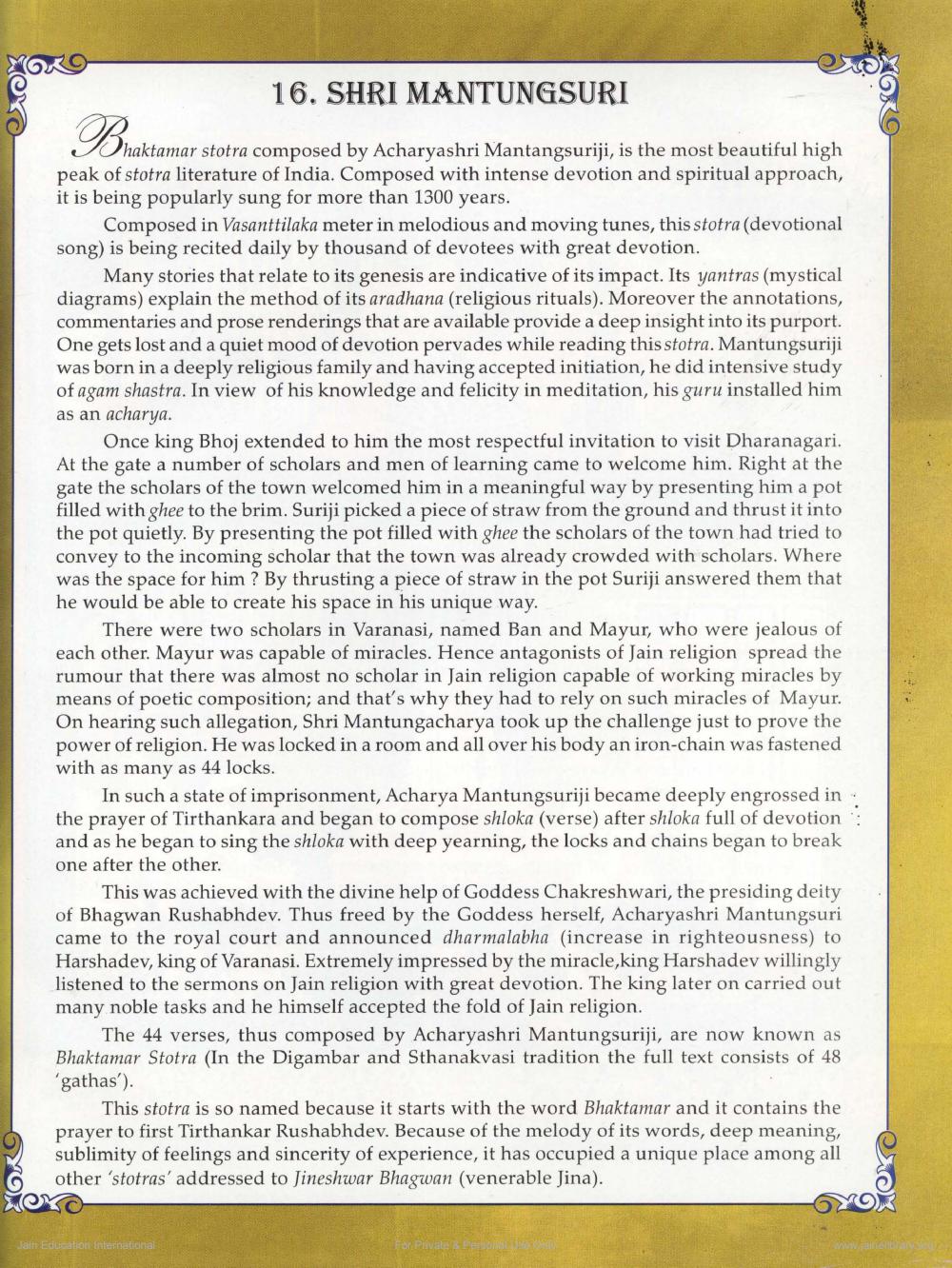________________
XOXC
16. SHRI MANTUNGSURI
S haktamar stotra composed by Acharyashri Mantangsuriji, is the most beautiful high peak of stotra literature of India. Composed with intense devotion and spiritual approach, it is being popularly sung for more than 1300 years.
Composed in Vasanttilaka meter in melodious and moving tunes, this stotra (devotional song) is being recited daily by thousand of devotees with great devotion.
Many stories that relate to its genesis are indicative of its impact. Its yantras (mystical diagrams) explain the method of its aradhana (religious rituals). Moreover the annotations, commentaries and prose renderings that are available provide a deep insight into its purport. One gets lost and a quiet mood of devotion pervades while reading this stotra. Mantungsuriji was born in a deeply religious family and having accepted initiation, he did intensive study of agam shastra. In view of his knowledge and felicity in meditation, his guru installed him as an acharya.
Once king Bhoj extended to him the most respectful invitation to visit Dharanagari. At the gate a number of scholars and men of learning came to welcome him. Right at the gate the scholars of the town welcomed him in a meaningful way by presenting him a pot filled with ghee to the brim. Suriji picked a piece of straw from the ground and thrust it into the pot quietly. By presenting the pot filled with ghee the scholars of the town had tried to convey to the incoming scholar that the town was already crowded with scholars. Where was the space for him ? By thrusting a piece of straw in the pot Suriji answered them that he would be able to create his space in his unique way.
There were two scholars in Varanasi, named Ban and Mayur, who were jealous of each other. Mayur was capable of miracles. Hence antagonists of Jain religion spread the rumour that there was almost no scholar in Jain religion capable of working miracles by means of poetic composition; and that's why they had to rely on such miracles of Mayur. On hearing such allegation, Shri Mantungacharya took up the challenge just to prove the power of religion. He was locked in a room and all over his body an iron-chain was fastened with as many as 44 locks.
In such a state of imprisonment, Acharya Mantungsuriji became deeply engrossed in the prayer of Tirthankara and began to compose shloka (verse) after shloka full of devotion and as he began to sing the shloka with deep yearning, the locks and chains began to break one after the other.
This was achieved with the divine help of Goddess Chakreshwari, the presiding deity of Bhagwan Rushabhdev. Thus freed by the Goddess herself, Acharyashri Mantungsuri came to the royal court and announced dharmalabha (increase in righteousness) to Harshadev, king of Varanasi. Extremely impressed by the miracle,king Harshadev willingly listened to the sermons on Jain religion with great devotion. The king later on carried out many noble tasks and he himself accepted the fold of Jain religion.
The 44 verses, thus composed by Acharyashri Mantungsuriji, are now known as Bhaktamar Stotra (In the Digambar and Sthanakvasi tradition the full text consists of 48 'gathas').
This stotra is so named because it starts with the word Bhaktamar and it contains the prayer to first Tirthankar Rushabhdev. Because of the melody of its words, deep meaning, sublimity of feelings and sincerity of experience, it has occupied a unique place among all
other 'stotras' addressed to Jineshwar Bhagwan (venerable Jina). XOXO
OXO
Jalte Edition International
For Fuva B
OLO




